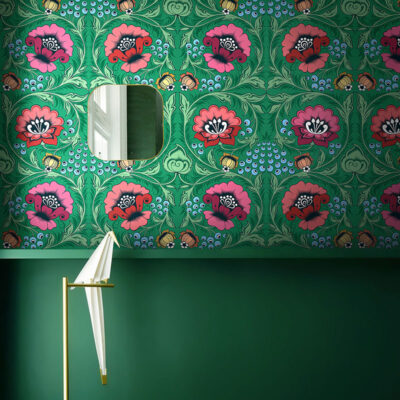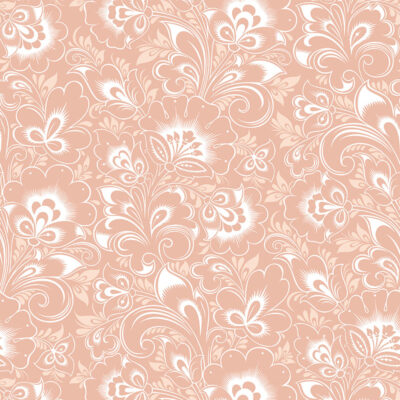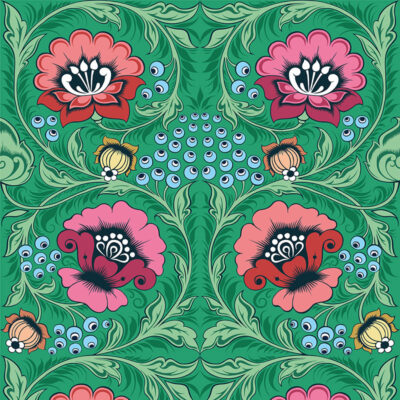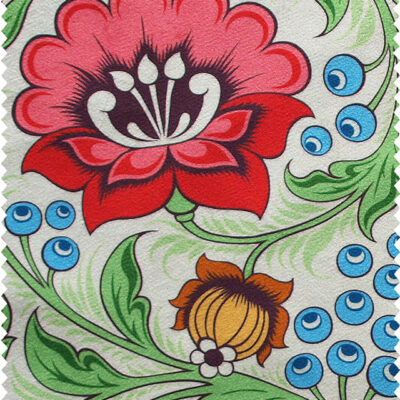Working as a Surface Pattern Designer for an international company I developed an eye for pattern and colour. During those years I realised that traditional Russian folk art was an amazing source of inspiration for homeware designs. Out of many traditional painting styles I decided to explore the striking Russian Khokhloma handicraft. I felt its intricate botanical patterns would work beautifully on wallpaper and textiles. The idea was followed by further research of the subject I believed I knew so well. Soon enough, I realised there was so much more to learn. And so in this blog post I would love to share the story of the most loved Russian craft and painting style.
Golden Khokhloma.
Khokhloma originated in the villages along the river Volga in the second half of the 17th century. The handicraft got its name from one of the product distribution centres, Khokhloma village. Around that time Russian craftsmen developed an original technique of painting on woodenware in golden colour without using gold. That ingenious invention made decorated wooden pieces look heavy and expensive. Ever since the craft has been known for its curved and vivid floral, berry and leaf motifs. Quite often we can also see the mythical Firebird from Russian Fairytales. One can instantly recognise the painting style by its signature red, black and gold colours. Although the craftsmen often added green, brown and yellow to brighten up their paintings.
- Khokhloma handicraft
- Khokhloma bowl and spoon
There are two types of Khokhloma painting – the so called “foreground painting” and the “background painting”.
“Foreground painting”.
In the “foreground” type artists paint on top of metallic surfaces creating exquisite botanical designs. They start by painting a few curvy lines (stems) defining the composition, to which they add the many pretty botanical elements. A classic example of that type of painting is so called “grassy” painting, where curved stems with black and red curls of “grass” strokes stand out against the golden background. Grassy patterns have always been particularly popular. There are also “leafy” and “berry” patterns, which, as their names suggest, include leaves and berries. It’s clear that Russian folk artists took their inspiration from nature, beautifully stylising its plant forms. Therefore it’s not surprising we can see many familiar wild flowers as well as strawberries, currants and raspberries in their paintings.
.jpg)
“Background painting”.
In the “background” type artists start by outlining their patterns on top of a golden surface. After that they fill in the background with one solid colour, usually black, leaving the pattern elements golden. Once the background is filled with colour, artists use brush strokes to decorate the golden elements in great detail. “Background” patterns feature curved botanical stems with lush flowers, leaves and sometimes fairytale birds. Next, artists add finishing touches such as curvy grass, small berries and flowers, which are painted on top of background colour. The “background painting” is considered to be a more time consuming process, requiring high skills and lots of experience from folk artists.
.jpg)
A more complex version of this type of painting is “Kudrina”, which means “Curls” or “Curly”. Folk artists outline the whole pattern, filling in the spaces in between with black or red colour. As a result, the curly golden leaves and flowers form a golden silhouette against contrasting background. Kudrina patterns denote unique quality and have an aura of being of high value.
The story of Khokhloma
In 1653 Patriarch Nikon announced reforms aimed to establish uniformity between Greek and Russian church practices. As a result, the Russian Orthodox church split into the official church and the Old Believers movement. The birth of Khokhloma craft is often associated with the Old Believers who, fleeing prosecution for “old faith”, settled in remote villages along the river Volga. There were highly skilled icon painters and miniature artists among them. At the same time the locals had wood turning skills, passed down from generation to generation. And so at the junction of those two traditions Khokhloma craft was born. It combined the unique art culture of the icon painters with traditional forms of turning articles of the Volga region craftsmen, preserving the secret of making “golden” kitchenware without using gold.
For two centuries Khokhloma kitchenware met the practical needs of the people. However, in the second half of the 19th century the perception started to change. The “Russian style” became fashionable leading to an increased interest in handicrafts as a form of art. In 1853 Khokhloma products were first presented at the Industrial Exhibition in Moscow, followed by a number of exhibitions in Paris, Sr. Petersburg and Nizhny Novgorod. It became very popular in Russia, selling widely at various fairs. Even the tsar’s family began to show interest in Khokhloma ware. And the product export increased significantly.
After the Revolution the school was not only preserved but also found significant support from the new Soviet government. During the First and Second World Wars women replaced male artists who didn’t return from the front. Ever since they began to play the main role in the factory team.
Started over 300 years ago, Khokhloma is still thriving and remains true to its roots.
.jpg)
The process of making Khokhloma.
The process of making Khokhloma hasn’t changed much since then.
First, any excess wood is removed with a cutter, creating the desired shape. Then, in order to keep the paints smooth and long-lasting, the rounded sides of the items are covered with clay soil. Next, the item is soaked in boiled linseed oil. After that aluminium powder (used to be tin powder) is rubbed into the surface of each item. And with the next step the magic happens! A layer of drying oil is applied before sending the item into a kiln. Baking turns “silver” into “gold”.
The artists breathe life into the pieces by decorating them with beautiful botanical patterns. They have a special technique of holding the brush, placing it on phalanges of index and middle fingers and pressing thumb against them. The technique allows to slightly rotate the brush while painting. All patterns are artistic improvisation, there is no preliminary drawing here.
The final step is varnishing and hardening in high-temperature kilns.
.jpg)
The past living in the present.
Khokhloma is a vibrant national phenomenon that has no analogues in the world. It symbolises the importance of forests and nature in Russian culture and its history, Russian hospitality and beauty. It is the past living in the present.
I learned the basic Khokhloma painting techniques during my school years in Russia. Many years have passed and it feels amazing to work with Khokhloma patterns again. I use the techniques I learnt a while ago to create new botanical designs inspired by Khokhloma. The aim is to create something new. For that reason I don’t tend to stick with the traditional colour palette. Instead, I draw traditional botanical patterns and then experiment with the colour schemes. And the result is a design that has a story. It’s a place where past and present connect.






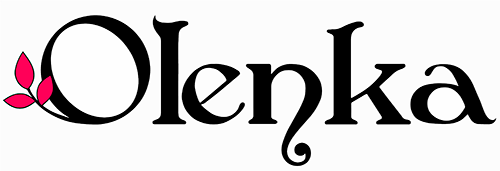
.jpg)



